Last week, I discussed the use of isometric exercises to provide a workout for those in restrictive positions. That article explained some of the theory behind these exercises, as well as their practice for the muscles of the upper body. This article will deal with the exact same subject matter, but for the muscles of the lower body instead (and no, this article will not discuss exercising the pubococcygeus muscles, please see one of my previous articles for a particular set of isometric exercises for working those elusive muscles).
A Review
Before we begin, let us review the basic principles of isometric exercise:
1. All isometrics are static, flexed positions, not dynamic movements
2. A full breath is done before the flexion, the breath is exhaled during the flexion, and the normal breathing resumes as the muscles are relaxed
3. Hold each flexion for 10-15 seconds
4. Do each exercise 2-4 times, depending on your preference.
With that being said, let us now discuss the positions that will work the lower body, as well as other muscles that were not worked by the exercises discussed in last week’s article.
The Exercises
These exercises, and the images of them, are once again taken from the “Black Monk” isometric set.
The first exercise is another one for the abdomen, a pose you’ll sometimes see referred to as the “Scrunch.” Lay down flat on the floor, and lift your legs up, bending at a 90 degree angle with your feet off the ground. Then bend at the abdomen, lifting the torso up until you cannot move forward any further. Then hold this position while holding your breath, exhaling upon relaxing the muscles.
The next exercise works the back, shoulders, and triceps: lay down on the floor, keeping the feet together, the legs straight and extended, and the arms in a “Crucifix” position. Then press down hard with the palms up.
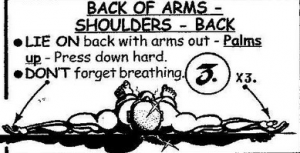
This exercise is done three times, with the arms held in three different positions as pictured
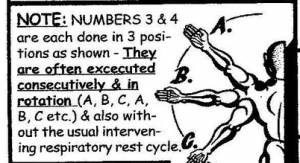
Then do the reverse of this exercise: lay on the stomach with the palms down, and push down with the palms down, remembering to breathe properly. This exercise will work the biceps, chest, and shoulders.
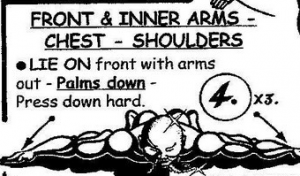
The next set of exercises are ones that actually work the legs:
To begin, sit down with the feet on the floor. Using the hands, attempt to press the legs together as hard as possible, while resisting with the legs. In addition to working the quadriceps muscles, this exercise also works the chest and shoulders.
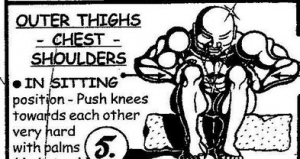
The next exercise also works the legs, but the calves and hamstrings rather than the quadriceps: While sitting on a chair and dangling the feet down, cross ankles and push one foot forward while pulling the other one back. Do two sets of each direction.
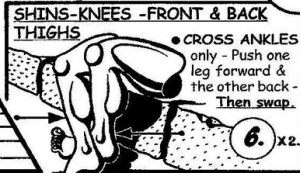
This next exercise works the inner thighs knees and groin: sitting in a similar position to the previous two exercises (sitting on a chair or bed with the feet dangling off them to the floor), put a folded up pillow, towel, or some similar padded object in between the legs. Then attempt to force the legs together. You can use a hard, rigid object (such as a box, or a watermelon), but bear in mind there is a risk of breaking, so use common sense.
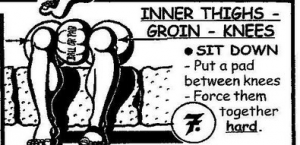
And finally, a “total body” isometric exercise that can be done is to lay flat on your back, with the arms crossed bend your head and the feet pointing up. Apply pressure through the elbows and heels, balancing the body on those body parts while lifting the back and buttocks slightly off the floor.
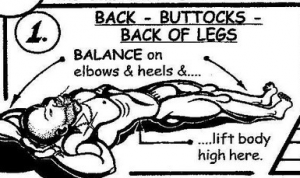
Conclusion
So concludes the hoary “Black Monk” isometric exercises. But these are certainly not the only applications of this style of muscular exercise. Indeed, any resistance exercise can be made into an isometric exercise by holding it in a static position. For example, a lifted weight can be held in a fixed position over head, this giving an isometric exercise to the shoulders and forearms.
Isometric exercise can also be combined with movement of other muscles to increase instability and thus force the muscles to work harder, such as in the overhead farmer’s walk: an exercise consisting of lifting a heavy weight over head (the static component) and walking while keeping the weight overhead (the dynamic component).
While isometrics are no substitute for traditional resistance training, they do have their place for any athlete.
Read More: Are Isometric Exercises Worth Doing?
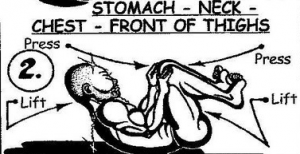
I thought that top pic was the cover of Van Halen’s 5150 album
Excellent post as always, LH.
It’s important for us to remember that there are exercises we can (and should) do even when we can’t get to the gym. The bodyweight stuff works great if you have the space, but isometrics can be employed in the office, on the couch, anywhere.
My personal favorites not listed are vacuums (clenching of the ab muscles), pec/shoulder tensing, fist clenching and unclenching, and calf/thigh tenses. They might not be as effective as the exercises listed, but they have the benefit of being virtually undetectable to the casual observer, and thus useful in public settings.
Thank you for the compliment. I actually discussed abdomen vacuums in last week’s article.
Vacuums are a personal favorite of mine too. I do them almost every day while at work.
In addition, I’ve had some success in the past performing other isometrics:’wall sits’ and ‘Rader chest pulls.’
The former works the quads and glutes. Anyone who played a high school sport like basketball, hockey or football should be very familiar with them. They are also a favorite of those in a position to dish out corporal punishment.
The latter exercise is a bit obscure, but I previously wrote about it here at ROK in response to an article on correcting posture. Rather than explaining it anew, I’ll quote myself:
“Rader chest-pulls: Stand inside of your bathroom door frame and face one of the posts, or stand facing some sort of a vertical support structure for a pullup bar, telephone pole, or street sign for instance. Reach out with straight or slightly kinked arms and grab it (roughly chin or eye level, whichever works for you after experimenting a bit), then take a deep breath and hold it while puffing out your chest and pulling down-and-in as hard as you can for five-to-ten seconds, then rest for a few seconds, and continue. If you are feeling an intense contraction in your abs, then you are doing them wrong; feeling them in your tris and lats is natural.
“These are mainly a ‘ribcage expansion’ exercise, which is controversial at best. Be that as it may, it feels like someone placed a balloon in my chest after a few sets of these… There is some anecdotal evidence out there that this exercise actually produces a bigger chest…”
Rader chest-pulls should work the chest, lats and tris in addition to its purported purpose as a ribcage expansion exercise. These are often equated with the dumbbell pullover–a classic exercise in the bodybuilding world.
Kratom
Yes, thanks!
These Kratom comments are getting annoying
You’ve created a paradox, because you have just posted one
No paradox is strong enough for Kratom! Also, more words with “x” in them are needed in the English language!
See my Pandora’s Box quote below
Indeed
I’ve had Pandora’s box. Meh. 6/10
Kratom has given you this insight too. All hail Kratom!
I’ve never liked them myself. I rarely find them to be funny.
I get it that guys want to blow off steam while bullshitting and busting balls, but I find the jokes to be inappropriate most of the time, unless some article deserves to be ridiculed. Legit articles like this one deserve a bit more respect in my opinion.
Larsen clearly put a lot of effort into this article/series, and the final product does justice to his efforts. I just think it cheapens the endeavor to shoot off at the mouth as if Larsen were bullshitting us to make a quick buck.
Once a Kratom comment in released onto the comments section……….more Kratomers come out of their Kratom cave to Kratom to each other! It’s like a virus
To be fair I agree. This article deserved more than my Kratom reference.
But Pandora’s Box is open
i once joked that i was going to write a perl script to generate random kratom jokes. it was a joke, but i really don’t think it would be that hard to do.
Kratom Quote Generator
kratomjoke.pl
It all increases the comment count, I don’t mind too much.
Haha. Sometimes I wonder whether authors use another account themselves to stir shit up to keep the comment count rising. I’m not suggesting that you do this.
Wow, well said!
some of us find blasphemy annoying
We have finally reached peak Kratom.
Are you The actual Dick Masterson?
I’ve read that strongmen of the early XXth century used isometrics a lot and were unbelievably strong, doing things like this :
https://s14-eu5.ixquick.com/cgi-bin/serveimage?url=http:%2F%2Fimg.breakingmuscle.com%2Fsites%2Fdefault%2Ffiles%2Fimagecache%2Ffull_width%2Fimages%2Fbydate%2F20131010%2Fsam5.jpg&sp=c0e5c12e063341b1f835d734dae7f894
That pic should be featured on those ‘this is why I need feminism’ t-shirts
Yeah.
That’s Alexander Zass. Real interesting story about his life. Just finished Reading about him. Real strong Dude.
Yeah I’ve read his autobiography a while ago. If I remember well he used to workout in WWI POW camps by pulling on his chains. Incredible character.
That’s exactly right. He Broke out of some prison camps by shredding his chains, and by bending the Bars so he could slip through.
I need to learn about this man.
I got the Book from Amazon. Also Goerner is another Strongman from the early 1900’s. He could Deadlift with one hand 730lbs 1 rep, and do a strict two handed barbell curl with 240lbs 1rep
Check out this guy, 65 years old, and has more in the Tank than most guys half his age.
well pretty much anything was better before, sums it up.
Are these good enough to use in a SJW-run gulag? In case my subversive realist nature causes me to be captured I want to make sure that I can overpower my doughy dick-loving captors and escape.
There is the most famous British Prisoner Charles Bronson who wrote a book about training in prison, mostly with isometrics. The man was ridiculously strong.
I loved the movie (huge Refn fan here), and I never read Bronson’s actual works, so correct me if I’m wrong but I think that you mean calisthenics (bodyweight training, often dynamic) rather than isometrics (static flexes/holds).
No his book ist mostly composed of isometrics, like pulling on a towell in different ways to strengthen different type of muscles, and also calisthenics . I read it ( a long time ago), after seeing the movie, which was a masterpiece.
Thanks. I always thought of him as more of a calisthenics guru in the fitness world. It’s interesting to me that he mostly employed isometric exercises. Maybe I should do myself a favor and actually pick up the damn book.
The only time I’ve ever seen towel exercises was with Kali Muscle–an ex-con. I’ve personally used a towel slung over a tree branch for pullups and as a sling/handle for lifting something else, but I’ve never considered using it isometrically.
http://www.amazon.com/gp/product/1844543099/ref=s9_simh_gw_g14_i2_r?ie=UTF8&fpl=fresh&pf_rd_m=ATVPDKIKX0DER&pf_rd_s=desktop-1&pf_rd_r=0CWG4MDRN5A6CBF090N4&pf_rd_t=36701&pf_rd_p=5d23eaf6-6278-49c1-b6df-7de0cb9b3a26&pf_rd_i=desktop
For your lower body:
Squat heavy.
Squat deep.
Squat often.
You’re doing at least one of those three things wrong.
Figure out which, and fix it.
That’s just a precious comment on an article about isometrics.
I’m a card-carrying advocate of “ass to grass” squatting, but that will be a topic for another article.
Never, ever skip leg day:
Never skip head day
lol
Fuck off.
Might try these exercises
Squeezing a canister of Kratom between your thighs, and holding the position for about 10 seconds (10-20 reps), can greatly increase overall leg strength…
Some of those look like physical therapy excercises I got after back surgery.